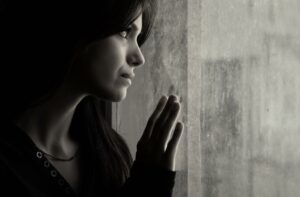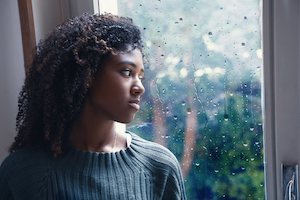Are you feeling a little down in the dumps lately? You’re not alone. According to the National Institute of Mental Health, an estimated 5 percent of Americans suffer from the seasonal affective disorder (SAD), a type of depression that occurs during certain seasons. If you think you might be suffering from SAD, it’s important to know what symptoms to look for and how to get help. In this blog post, we’ll discuss what causes seasonal depression, common symptoms, and treatment options.
Contents
What Is Seasonal Depression?
 Seasonal depression is a type of depression that occurs at the same time every year. It is usually during the fall and winter months, but can occasionally happen in the spring or summer. Seasonal depression is sometimes called seasonal affective disorder (SAD). This condition is more common in women than men and usually starts when a person is between the ages of 18 and 30.
Seasonal depression is a type of depression that occurs at the same time every year. It is usually during the fall and winter months, but can occasionally happen in the spring or summer. Seasonal depression is sometimes called seasonal affective disorder (SAD). This condition is more common in women than men and usually starts when a person is between the ages of 18 and 30.
More often, studies suggest that people who live in northern climates are more likely to suffer from seasonal depression. The main theory is that the lack of sunlight causes a chemical imbalance in the brain. Also, seasonal depression affects between 0.5 to 2.5 percent of the population in North America.
However, the condition is not just limited to people in cold climates. Some research suggests that as many as 20 percent of people in the United States suffer from some form of winter blues.
What Are The Symptoms Of Seasonal Depression?
The symptoms of seasonal depression, also known as seasonal affective disorder (SAD), are similar to those of major depression. However, they tend to be more severe and happen during a specific time of year. In general, the symptoms of seasonal depression are divided into two categories: Winter patterns, and Summer patterns.
Winter pattern
This is often the more common type of seasonal depression. It typically begins in the fall, as the days get shorter, and continues into the winter months. In this type of depression, the signs and symptoms may include:
- daytime fatigue
- overeating
- lack of interest in activities
- laziness and weight gain
Summer pattern
In the summer pattern, people with seasonal depression feel better in summer and worse in winter. This condition is sometimes called “reverse” or “summer” seasonal affective disorder (SAD). The symptoms in this pattern are:
- agitation
- difficulty sleeping
- acting out violently
- weight gain
- lack of appetite
- increased restlessness
These are just a few of the symptoms associated with summer patterns seasonal depression and winter. It is often hard to tell the difference between the two because they both cause people to feel down. However, there are some key differences that you should be aware of.
Overall, the symptoms of seasonal depression are the same, regardless of the pattern. However, it is important to be aware of the different patterns so that you can seek treatment if necessary.
What Causes Seasonal Depression?
 The causes of seasonal depression are not fully understood. Still, there are some causes that seem to be more common in people with this type of depression. These include:
The causes of seasonal depression are not fully understood. Still, there are some causes that seem to be more common in people with this type of depression. These include:
Change in Amount of Sunlight
A change in the amount of sunlight may play a role in seasonal depression. In the fall and winter, when there are fewer hours of daylight, people with seasonal depression may not get enough natural light. More often, the amount of sunlight is reduced due to shorter days and longer nights.
Change in Sleep Patterns
Seasonal changes can also disrupt a person’s sleep patterns. The shorter days and longer nights of autumn and winter may cause people to go to bed earlier and wake up later. This can lead to sleep problems, which can worsen seasonal depression. Also, sleep patterns may be affected by the increased use of artificial light, such as from computers, TVs, and phones.
Change in Body Clock (Circadian Rhythm)
The body’s internal clock, or circadian rhythm, regulates the body’s natural sleep-wake cycle. Seasonal changes can disrupt the body clock, which can cause fatigue and make seasonal depression worse. The body clock is also affected by the change in daylight hours. It is often hardest to adjust to the time change in the fall when daylight savings time ends and clocks are set back an hour.
Certain Brain Chemicals
It is believed that seasonal depression may be caused by a change in the levels of certain brain chemicals, such as serotonin and melatonin. Low levels of serotonin are linked to depression. Melatonin is a hormone that helps regulate sleep. A change in the level of this hormone can cause sleep problems. Those brain chemicals in seasonal depressions may be affected by the reduced amount of sunlight.
Genetics
Seasonal depression may run in families. This suggests that genes may play a role in this type of depression. In fact, genes are responsible for many of the mental health conditions that people experience. In fact, studies have shown that people with seasonal depression are more likely to have a family member with the condition.
So, these are some of the possible causes of seasonal depression. If you are experiencing any of these symptoms, it is important to talk to your doctor. They can help you find the best treatment for your condition.
What Are The Risk Factors?
 The condition is more common in women, people with a family history of depression, and those who live farther from the equator. The seasonal affective disorder might be caused by reduced sunlight exposure during winter. This can disrupt your body’s internal clock and trigger symptoms of depression.
The condition is more common in women, people with a family history of depression, and those who live farther from the equator. The seasonal affective disorder might be caused by reduced sunlight exposure during winter. This can disrupt your body’s internal clock and trigger symptoms of depression.
There are several risks associated with seasonal affective disorder. These include:
The risks in the winter are higher than the risks in the summer. However, the risks are still present in the summer. Moreover, the risks are present all year round.
So, if you think you might be suffering from seasonal depression, it is important to talk to your doctor. They can help you manage your symptoms and get the treatment you need. You just have to be willing to ask for help.
How To Diagnose Seasonal Depression?
The diagnosis of seasonal affective disorder can be tricky. Many people experience the “winter blues” during the colder, darker months of the year, but not everyone meets the criteria for a diagnosis of SAD.
So the basic process of diagnosis can be done through an evaluation that includes:
- Physical exam: This is to rule out other potential causes of your symptoms, such as a thyroid problem. Because, in some cases, seasonal depression can be linked to other physical health problems.
- Blood tests: To check whether you have a vitamin D deficiency.
- Psychological evaluation: This may be done by a psychiatrist, psychologist, or clinical social worker. He or she will ask about your thoughts, feelings, and behaviors to see if they meet the criteria for seasonal affective disorder.
These three types of evaluations can help your doctor come to a diagnosis. If you think you may have SAD, talk to your mental health professional about your symptoms and whether this disorder could be the cause. These methods of diagnosis are many ways helpful in general for seasonal depression.
If you think you may have SAD, speak to a mental health professional. They can help you manage your symptoms and develop a treatment plan. As SAD is a real medical condition that requires treatment. So, hesitate to reach out for help.
How To Treat?
The treatment for such a condition is required before it causes problems in your life. There are several treatment options that are widely used for it. These include:
Light Therapy
Light therapy involves sitting in front of a special lightbox for 30 minutes each day. The lightbox emits full-spectrum bright light, which is thought to have a positive effect on brain chemicals linked to mood. It works best when it’s done first thing in the morning. However, this type of therapy consists of daily treatments and can be expensive.
There are some side effects of light therapy, such as:
- eye strain,
- headaches, and nausea.
It’s important to talk to your doctor before starting this type of therapy. Also, you should avoid considering this therapy if you have:
- bipolar disorder,
- history of mania,
- or are taking medications that can make you sensitive to light.
Antidepressant Medication
Antidepressants can help improve mood and ease other symptoms of seasonal depression. These medications need to be taken every day and may take several weeks to start working. It is believed that they work by helping to balance brain chemicals.
There are some side effects associated with antidepressant medications, such as:
- nausea,
- headaches,
- weight gain, etc
Again, it’s important to talk to your doctor before starting this type of medication. Also, if you have a history of bipolar disorder, you should avoid taking antidepressants.
Psychotherapy
Psychotherapy is a type of counseling that can help you understand your thoughts and feelings and how to manage them. It can be done individually or in a group setting. This type of therapy can be helpful if you have seasonal depression that doesn’t respond to light therapy or medication. The major types used in this therapy are:
- Cognitive-behavioral therapy (CBT)
- Interpersonal therapy (IPT)
Both of these types of therapy have been found to be effective in treating seasonal depression. In fact, CBT work has shown to be especially helpful in preventing seasonal depression from coming back. However, there are some side effects associated with psychotherapy, such as:
- anxiety,
- depression,
- irritability.
Self-Care Tips
 This is often the first step in treatment. It involves making some lifestyle changes and paying attention to your own well-being. Some self-care tips that can help include:
This is often the first step in treatment. It involves making some lifestyle changes and paying attention to your own well-being. Some self-care tips that can help include:
- get outside every day,
- exercise regularly,
- eat a healthy diet,
- get enough sleep,
- avoid alcohol and drugs,
- manage stress,
- practice relaxation techniques.
These self-care techniques can help improve your mood and ease some of the symptoms of seasonal depression. However, if these methods don’t work, it’s important to talk to your doctor about other treatment options.
Support Groups
This is often an option that is available for people who suffer from seasonal depression. There are different types of support groups, but they all provide a space for people to talk about their experiences. These can be an invaluable resource for people who suffer from seasonal depression.
Support groups are very beneficial in treating seasonal depression. They offer several benefits, such as:
- A space to share your experiences with others who understand what you’re going through
- An opportunity to offer and receive support from others
- An outlet to talk about your feelings
If you’re interested in finding a support group, there are a few ways to go about it. You can ask your mental health professional for more understanding about it. Seasonal depression is a treatable condition and there are many options available.
You can contact Mantra Care, a leading provider of mental health services, for more information. The team of experts here can guide you through the different treatment options and help you find the one that’s right for you. Get in touch with us today to learn more. Book your free consultation now!
Conclusion
To conclude, seasonal depression is a type of depression that is brought on by the change in seasons. It typically occurs during the fall and winter months when there is less sunlight. Seasonal depression can be mild or severe, and it can impact anyone at any age. If you think you may be experiencing seasonal depression, talk to your doctor or mental health professional. There are treatments available that can help you feel better.
In fact, many people with seasonal depression find that their symptoms improve or go away completely once spring and summer arrive. So, if you’re feeling down this winter, don’t despair. The sun will be back before you know it. You just need to hang in there until then.
For more information, please contact MantraCare. Depression is a mental illness characterized by persistent feelings of sadness, hopelessness, and loss of interest in daily activities. If you have any queries regarding Online Depression Counseling experienced therapists at MantraCare can help: Book a trial Depression Therapy session


